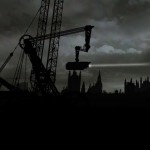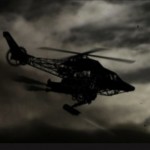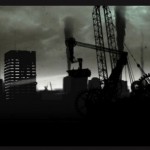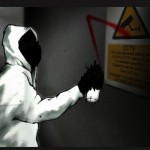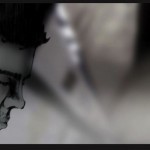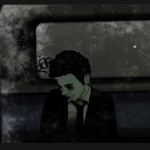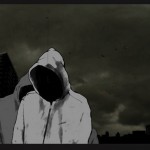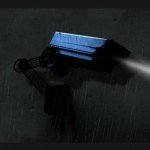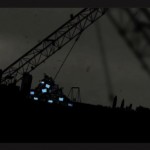TTransfer Operations and Intersemiotic Translation in Alex Robinson’s London
by Remo Gramigna
University of Tartu
The present paper presents a semiotic analysis of Alex Robinson’s London[1], a short animation inspired by William Blake’s homonym piece of poetry, namely “London”. Animation remediates poetry creating a novel expressive form by means of a heterogeneous range of multimodal semiotic resources. A new world-view arises, parallel to the one envisaged by the source text, although divergent. The aim of this essay is to show and explain the way in which the semiotic resources used by the director Alex Robinson model and shape the discourse and aesthetic of the animation, creating a new, blurred language as well as a novel ‘semiotic reality’. The paper shall focus on the analysis of transfer operations employed in the translation from the source text (Alex Robinson’s London) to the target text (William Blake’s “London”) and it shall consider why and to what extent Robinson’s London is to be considered an intersemiotic translation of Blake’s poem.
1. Introduction.
Much ink has been spilled over the issue of poetry as a specific artistic form and its peculiar place within semiotics, literature and translation studies. Poetry is often seen as a literary form that retains a certain degree of untranslatability for it is governed by a unique logic of mutual meaningful relationships between the signifier and the signified. To put it with Roman Jakobson: “[…] poetry by definition is untranslatable. Only creative transposition is possible” (Jakobson 1966 [1959]: 238). As Dirk Delabastita has pointed out:
[…] Poetry is indeed characterized by the simultaneous presence of different organizational patterns (line, metre, sound repetitions, syntax, isotopies, etc.), which in various ways interact with each other and with the underlying layers of linguistic and cultural meaning. The result is a highly complex unity in which it is no longer possible to distinguish between signifiers and signifieds: both fuse together into one single total sign, which is the perfect icon of the unique world view it embodies (Delabastita 1993: 29).
Such a view is arguably informed by theories of Tartu-Moscow semiotic school. In particular, Delabastita draws on Juri Lotman’s conception of the artistic text. There is not enough room in the present academic endeavour to linger over such broad issues like poetry and artistic text. These introductory notes may serve as a reminder of the particular nature of the topic the present paper seeks to address, that is, the animated adaptation of a piece of poetry. The current essay analyses a particular case of creative transposition, namely, intersemiotic translation in Alex Robinson’s three minute animated movie London (2010). As stated above, this short animation is admittedly inspired by William Blake’s homonym piece of poetry, which dates back more than two hundred years ago (1794)[2]. Thus, the current work faces the issue of transposition of a poetic text into an audio-visual, animated one; namely, from one medium into another. More precisely, from one sign system into a different one. As it will become apparent in the analysis that follows, the animation maintains the source text’s main themes (in terms of content) and its dominant (in terms of form) actualizing it within another time-space (contemporary), with a total effect of modernization. This contention will be elaborated in the following paragraphs. Before addressing the aforementioned issues an overview of preliminary concepts of semiotics of translation is in order.
2. Theoretical background
Before starting our examination, I would like to linger over some theoretical concepts that serve as background for the semiotic analysis of the animation London, that is, intersemiotic translation and types of translation. Let us first briefly recall the famous distinction of three types of translation singled out by Roman Jakobson. In his seminal work “On linguistic aspects of translation” (1966 [1959]), the author distinguished between intralingual translation or rewording, interlingual translation or translation proper and intersemiotic translation or transmutation, the latter defined as “an interpretation of verbal signs by means of signs of nonverbal sign systems” (Jakobson 1966 [1959]: 233). For Jakobson these three different types of translation represent different aspects of the same translation process. The text that the current work aims to analyse, Alex Robinson’s London, falls under the rubric of intersemiotic translation inasmuch as it interprets verbal signs, e.g. William Blake’s poem, by means of a nonverbal sign system, e.g. animation. Now, as we know, animated cinema aesthetics incorporates different sign systems, for it is a multimodal medium. Therefore images, speech, written text, sounds and so forth – in one word all semiotic materials at disposal – work together in synthesis, creating a coherent whole. To borrow an expression formulated by Roman Jakobson, this is a case of “syncretic message” inasmuch as it is “based on a combination or merger of different sign patterns” (Jakobson 1971: 705). In essence, the medium creates its own language. This is what goes under the rubric of ‘medium specificity’ or ‘medium identity’, which means that each medium has its own way – e.g. specific language – of showing/telling/mediating reality.
In the case of Robinson’s London, video “remediates” (Bolter and Grusin 2000) poetry inasmuch as it retains certain isotopies or themes present in the source text transposing them by means of a different language with a total effect of modernization. To be sure, the source text (Blake’s “London”) is maintained by means of repetition. Blake’s poem is in fact uttered by the narrator’s off-screen voice which is present in the target text in form of oral narration or speech. The visual text (Robinson’s London) is accompanied by the narrator’s voice over that recites the poem[3]. Thus, Blake’s poem becomes voice, articulated sound within Robinson’s short animated film. As a matter of fact, the source text is embedded in the target text.
To sum up, the question to be examined concerns the nature of this relationship between source text and target text and their respective languages, the way in which the animation manipulates available semiotic resources in order to render an animated transposition of poetry that is at the same time recognizable but deviant, coherent but modern, similar but different. The issue at stake may be stated in the following terms: why and to what extent is Alex Robinson’s short animation a case of intersemiotic translation? It is the age-old problem of identity and difference, repetition and innovation. Among many media available, Robinson’s choice of filmic animation modality certainly determines the result of his product. Animated text is shaped by the semiotic resources available and the concrete usage and arrangement skilfully made by the film-maker. Indeed, the process of translation is always a decision making process (Delabastita 1993: 8), and translation or adaptation is always an interpretation (Eco: 2001), one among the array of possible interpretations.
3. Intralingual translation and intersemiotic translation in the animation of London
A creative transposition, such as the text analysed by the present essay, cannot escape its inner “double” nature, namely the legacy with the source text. As Peeter Torop pointed out:
A screen adaptation can be seen as an autonomous film picture, but it is a double text (as translation or parody) for the man who knows the source text: the comparison between the film and the text would be psychologically inevitable. It follows that reading cannot be separated from film viewing (Torop 2000: 87).
The competent viewer thus recognizes the source text as Blake’s “London”. It is a case of explicit intertextuality, for Alex Robinson clearly stated that the animation London is inspired by Blake’s poem. As it is pointed out in the freelance British illustrator’s website:
The movie is a modern interpretation of William Blake’s ‘London’ as relevant today as 200 years ago. Each line of the poem inspires a futuristic yet gritty parallel of Blake’s London. The film endeavours to visualize how Blake may have envisioned the London of our times and by doing so draws upon uncanny and un-nerving similarities[4].
Thus, there exists a dialogue between texts, a familiar text in the British culture’s collective memory that becomes a repetition, a stable invariant in the novel alien text (Robinson’s London).
As pointed out above, the source text is reproduced as oral narration in the target text. To wit, the narrator recites Blake’s “London”. Thus, there exists not only one kind of translation, namely intersemiotic translation as pointed out above (from poetry into animation), but also an intralingual translation or at least the transfer from written language into oral language, inasmuch as Blake’s “London” is recited within the frame of the video, thus becoming a voice over that accompanies the animated film.
Roman Jakobson defined “intralingual translation” as “the interpretation of verbal signs by means of other signs of the same language” (Jakobson 1966 [1959]: 233). Technically it is therefore inappropriate to name an oral recitation of a written piece of poetry a proper intralingual translation inasmuch as it does not occur any rewording. In the animation there occurs repetition in the sense that there is “the recycling or ‘reproduction’ of texts or text elements” of the source text transferred in the target text (van Gorp 2004: 62). However, there is no general agreement around this matter. If “intralingual translation” is viewed as encompassing repetition or remediation from one medium into another, then it can be said that intralingual translation does occur as well. If, on the contrary, Jakobson’s category of intralingual translation is taken as involving “saying something using other words from one’s own language” (Eco 2001: 75) then the oral recitation of a poem cannot fall under this category.
For Eco, however, the interpretation of verbal expression “by a visual expression, a gesture, or a sequence of sounds” it is not necessarily to be considered as intersemiotic translation “insofar as the use of non-verbal interpretants to interpret a verbal expression is much more internal to linguistic praxis” (Ibid: 75-76). Umberto Eco revised Jakobson’s typology proposing his own threefold classification of translation. He distinguished between interpretation by transcription, intrasystemic interpretation and intersystemic interpretation (Ibid: 100). The first category entails the “simple substitution of codes as, for example, in case of Morse alphabet” (Torop 2002: 597). Intrasystemic interpretation includes the subclasses of intralinguistic interpretation (with the same natural language), intrasemiotic interpretation (within other semiotic systems) and performance (Eco 2001: 100). As for the last category Umberto Eco provides examples mainly concerning theatre and the interpretation of a musical score into performance as for instance a performance of Beethoven’s Fifth (Ibid: 75). As the author pointed out:
[…] In performance the same form of the expression is rendered through a change in expressive purport, because what usually happens is that we pass from the notation of a written score (and a theatrical piece can also be called a score) to its realization in sounds, gestures, or words pronounced out loud. But a score is always a set of instructions for the realization of allographic works of art, as Goodman (1968) calls them, and therefore it already provides for and describes the matter in which the work must be realized, in the sense that […] a theatrical text prescribes that the written words must be rendered as vocal sounds (Eco 2001: 104).
Eco’s view about performances may be applied as well to the recitation of a poem inasmuch as written text is rendered into vocal sounds. However, drawing such a parallel may be misleading in the case of the oral reproduction of a poem that is present in an animated video as voice over inasmuch as one of the distinctive features of performance, that is, the live presence of performers in a certain place and time, is missing in the case of animated film, along with the authenticity that is at the core of the experience of “liveness” (Auslander 2008).
To sum up, the question to be addressed concerns the way in which the filmmaker translates the parallel between Blake’s vision of London mediated by the poem and his own interpretation of it, transposed into the language of animation[5]. What are the strategies and transfer operations used? What kind of translation takes place? What is the total effect perceived by the viewer? What is the dominant of the target text and how does it relate with the source text? Before answering these questions, let us now take a close look at Alex Robinson’s animation providing a brief description of it.
4. London as seen
Alex Robinson’s London lasts three minutes and twenty seconds and it centers around the daily metropolitan experience of a perfect stranger dressed in tie and suit and his path through the city. During the first ten seconds the animation shows the suited businessman standing behind a yellow line painted on the pavement. After a few seconds a fast vehicle arrives. At this point the viewer is able to recognize that the location showed is an underground station and that the approaching vehicle is a metro. It follows with a close-up on the businessman’s face (Fig. 6) and then the title appears: London. The target text carries the source text’s title as it is, by means of repetition. It follows a tracking shot from left to right on a city landscape. The viewer easily recognizes it as a metropolitan landscape, for it depicts skyscrapers, palaces, industrial chimneys and fumes that go up in the grey sky. The landscape portrayed is London and the viewer is able to recognise it by the fact that the animation shows a building that strongly resembles the Westminster Palace, an icon of the capital of England (Fig. 1). The setting displayed by Robinson is ultramodern, futuristic I would say; a sort of post-modern interpretation of contemporary London’s landscape. Industrial fumes pollute the sky and futuristic helicopters move in the air (Fig. 2). It seems a city under construction for it displays some kind of machinery to which a video camera is fixed (Fig. 3). The landscape depicted resembles the futuristic scenario of films such as Blade Runner (Scott, 1982) or the gothic architecture and panorama of Gotham city depicted in Burton’s Batman (1989). It also recalls the black and white contrast of urban landscapes in the more recent Sin City (Miller & Rodriguez, 2005) and the suited man presents remarkable similarities with the cartoon-like animated characters portrayed in A scanner darkly (Linklater, 2006)[6].
What is apparent is the overall ‘mood’ communicated through the animation: darkness, pessimism, negativity, distrust. These qualities are rendered on a chromatic level by the contrast of black/white colours and the pre-eminence of dark, gloomy tints. Sporadically other colours appear: the “mind the gap” yellow line of the tube in the introductory scene; the red graffiti on a city wall (Fig. 4); the red colour of the “adult service” card held by the protagonist towards the end of the movie (2:03); the yellow colour of a CCTV camera street sign (Fig. 4); the red, blue and white of the London’s tube logo utilized as closing credits (2:45). The universe depicted by the movie, namely its semiotic reality, is a grey, dark world. This view perfectly attunes with the general attitude of the source text. William Blake’s poem presents a pessimist vein for it portrays a hopeless world where no future is envisaged. Blake’s London is a place of alienation where man has no rights, where prostitution and moral dirt reign. As several commentators pointed out, Songs of Experience “are generally thought as bitter poems”, they are “generally called poems of disillusionment” and […] “they protest against and satirize a state of affairs which need not exist” (Hirsh 1964: 93-95).
Hitherto I have been using very generic terms such as ‘mood’ and ‘attitude’ in order to describe the general feeling evoked by Robinson’s short animated movie. A better grasp of what I mean by these terms is given by the concept of “dominant”, defined by Roman Jakobson as follows:
The dominant may be defined as the focusing component of a work of art: it rules, determines, and transforms the remaining components. It is the dominant which guarantees the integrity of the structure (Jakobson 1981: 751).
The concept of the dominant as the “skeletal, form-giving element” which is “foregrounded and deforms to its need all the other elements” (Steiner 1980: 93) is apparent in the organization of the target text: all elements (colours, style, music, sounds, speaker’s tone of voice) are attuned and organized by the same element, that is, the darkness of the text. For the present it suffices to have pointed out such identity: the target text uses semiotic resources at its disposal to mime, render and transpose the same dominant using a different medium. However, a similar claim does not provide an explanation of the way in which each of the semiotic resources used contributes in making this effect. Let us examine this issue in more details in order to show how different semiotic resources create the reality mediated by the animation. However, before tackling the aforementioned issue, a close look at the structure of Blake’s poem is needed.
5. London as heard.
If we are to study expressive languages and their reciprocal influences we cannot avoid looking at the specific way in which poetry renders its meaning and organizes its structure. Blake’s “London” is composed of four stanzas and is written in the first person “I”. This symbolizes the subjective experience of “an alienated, observer’s account of the city” (Glen 1983: 215). As we can infer from a linguistic analysis of Blake’s poem, the language is soaked with negative terms: “weakness”, “cry”, “fear”, “appals”, “blood”, “blights”, “plagues”, “hearse”. The use of such negative vocabulary shows the writer’s attitude towards the city. Man is portrayed as hopeless, without freedom, oppressed with “mind-forged manacles”. The writer’s attitude towards the city is translated into the animated movie by focusing on themes of anonymity and alienation. After depicting the city landscape, Alex Robinsons shows indistinguishable man-like figures or shadows walking through the screen. 55 seconds have passed until this scene. In this moment the narrator’s voice over starts to recite the first stanza of Blake’s poem:
“I wander thro’ each charter’d street,
Near where the charter’d Thames does flow,
A mark in every face I meet,
Marks of weakness, marks of woe”[7].
Themes of anonymity and alienation are rendered in the animation by depicting faceless human figures. In the world represented by the movie there are humans, although there is no humanity. The only face portrayed that displays distinctive and recognizable facial features is the one of the suited businessman that wanders through the city (Fig. 5-6). The rest are faceless characters (Fig. 7). However, the protagonist is represented as a cartoon-like figure as well as all the other human characters that appear in the movie. The animation was in fact made by “a mixture of different medias, the bulk of it was hand drawn over live footage. Alex created the backgrounds with a montage of photos/ drawings and live footage all composited together in After FX” [8]. The particular semiotic resources used symbolize the entrance in a different, parallel reality, to wit, a meta-reality.
The “wandering” metropolitan experience envisaged by Blake’s poem is translated into a modern analogue in the target text. Blake portraits the city of London as a place where everything is owned, “chartered”, even the river. If everything is owned, this equals to say that there is a lack of individual freedom. This is one of the main theme of the first stanza as the double repetition of the word “chartered” indicates. Likewise, the word “mark” is repeated twice[9]. Repetition is “the most striking stylistic device used by Blake” (Mazarweh 2010 :6). The word “mark” (lines 3 and 4) has a double meaning: it refers to the physical marks of suffering carried by people as a consequence of the unequal conditions they experience, and it also suggests the speaker recording evidence during his stroll through the city. How is this double meaning translated via the filmic devices? I argue that the target text opts for a translation strategy that seeks for cultural analogies in the target cultural code. This view if informed by Dirk Delabastita’s account on translation. According to Delabastita, “a cultural analogue […] would precisely attempt to establish approximate equivalence on the cultural plane […]” (Delabastita 1993: 17-18).
I suggest that the sense of ownership and consequently lack of personal freedom present in Blake’s poem is translated by displaying a cultural analogue, namely CCTV[10] camera. I believe that this is a key element for understanding the way in which the target text translates the source text. The world depicted by Robinson is a surveillance society. The CCTV camera is a visual element that is recurrent throughout the all movie. In the beginning we see a helicopter flying above the city and a camera held by a mechanical arm fixed above to the flying vehicle (Fig. 2). Surveillance cameras appear once more as an attribute of the landscape (Fig. 3). Then it follows a close up on a CCTV camera (fig. 8) and a pile of television screens is shown at the end of the first stanza (fig. 9). Thus, the surveillance camera is a key element in the modern translation of contemporary London made by the cineaste. It is worthy to remember that CCTV camera is a widespread contemporary device spread specially in the UK where there has been a proliferation of such devices since recent decades. It could be even argued that the whole animation is showed as if it has been filmed by a (hidden) CCTV camera recording from above (Fig. 10). I argue that CCTV camera represents an analogue cultural meaning that is used in the target text to translate the linguistic meaning carried by the repetition of “chartered” and “mark”. Likewise Blake’s London, where everything is owned and repressive institutions like church, monarchy and marriage create “artificial constrictions”, “manacles that are mind-forged” (Hirsh 1964: 93-94), the metropolis visualized in the animation is dominated by surveillance cameras that inevitably restrict individual freedom. At the same time, the device of the camera depicted in the animated movie helps translating the double linguistic meaning of the word “mark”. On the one hand, as in the poem, human faces are marked by the gaze of the metropolitan flâneur. On the other hand “marks of weakness, marks of woe” are recorded by the ubiquitous presence of the CCTV cameras. The latter, therefore, works as a cultural analogue in the target cultural code. I argue that this is one of the main strategies used by the director to translate the relevant meanings/themes present in each Blake’s stanza. As pointed out above, this claim is informed by Dick Delabastita’s insights on typology of translations. The author distinguished between linguistic codes and cultural codes and singled out two main strategies of translation: analogical and homological. The latter strategy according to Delabastita:
“[…] consists in the replacement of S.T. – S.ling.code items by T.ling.code items which optimally reflect their cultural rather than linguistic meaning. In other words, the resulting T.T. item has an analogous cultural meaning; its relative value within the T.cult.code is an optimal approximation of the rational value of its S.T. counterpart within the S.cult.code” (Delabastita 1993: 17)[11].
In order to clarify his viewpoint Delabastita provides the example of “creaking shoes” mentioned by Shakespeare in King Lear, a linguistic item that on a cultural plane may find its analogue by means of “some high-class or flashy twentieth-century footwear brand” (Ibid: 18).
Probably it is improper to talk about “T.ling.code items” in the case of filmic adaptation. Perhaps a more appropriate terminology is needed to theorize the role of such “cultural analogues” within the animated medium. In order to overcome such difficulty I shall borrow the terminology used by Dean MacCannell (1999 [1976]) in his semiotic analysis of tourist attractions. He uses the generic term marker to mean “information about a specific sight” and makes a distinction between on-sight marker, “information found at its sight” and off-sight marker, “information that is separated from its sight” (Idid: 110-111). For instance the Eiffel Tower is a marker of Paris as well as the Colosseum is a marker of Rome. I contend that such terminology may be fruitfully used in identifying target cultural code items used to translate source linguistic code items employed by William Blake for describing the city he was living in. Therefore I shall now list off-sight markers used by Alex Robinson to show the viewer that the city at stake is actually London:
1) The title;
2) London’s tube or underground;
3) CCTV camera;
4) The Westminster Palace.
5) London’s tube logo.
The third element has been already discussed and the first, second, fourth and fifth have been briefly mentioned during the description of the landscape showed by the film. Now I would like to spend a few words on the second marker: the tube, for it is the quintessential symbolic representation of London as such. I argue that London’s underground represents the element par excellence in symbolizing insofar as it represents the contemporary marker of the metropolis and therefore it is used by the author to translate the whole metropolitan experience of the alienated man who “wanders” through the city. The fact that the tube is used as symbolic marker to identify London is also apparent from the closing credits (n.5 in the list of markers) in which the logo of London’s underground is taken as layout where to display the names of the author and staff who contributed to the realization of the film. If Blake’s stroll around the streets of London was probably made on foot or by carriage, Robinson’s alienated man with suit takes a ride by tube. Since the very beginning of the film the experience of the city is mediated by the metropolitan experience of the tube. A man stands before a yellow line. A few seconds of silence. Then a strong, fast metallic noise signals that a fast vehicle is arriving, and suddenly the viewer is able to recognize the familiar noise made by a metro that is coming closer and closer. Then the title appears and we cannot mistake: it is London.
Sounds and noises play of course a crucial part is signifying the city and translating the metropolitan experience. Film animation as an expressive device talks the language of the modern metropolis. It represents its sounds and noises, its constant flow, its rhythm. Sounds are a crucial component in the source text as well representing the soundscape produced by the city. There are cries, the sound of “mind-forg’d manacles” and curses. These sounds are all the result of anguish and pain, caused by conditions in the city. As Annika Bräuer pointed out “the sense of hearing is of great importance to Blake which can be seen by the use of an acrostic. In the third stanza the first letter of each line read top down results in the word “HEAR” in capital letters” (Bräuer 2008: 4).
Watching Robinson’s London without sounds is a totally different experience than watching it while listening to it. Not only because the voice over who narrates the poem would not be heard otherwise, but also because the sounds and noises employed by the movie reinforce and reassure the audience of viewing a metropolitan story about London. The spectator hears the metallic noise of the tube, the noise produced by helicopters flying in the grey sky, police sirens, bits of radio transmissions, a thunder, a church’s bell, the noise of a march, traffic, people walking, rain sounds, the sound of the spray paint, the zoom noise of a camera and the musical theme of the animation. Undoubtedly, music is important too, as well as the voice’s tone and timbre of the male narrator who recites the poem. His pauses are extremely significant for they give the rhythm to whole filmic text and provide the tempo for the entrance of the musical theme. Daniel Boyle produced the music for the animation. The main theme, played by a piano on a minor scale, attunes with the pessimist and dark dominant of the target text, producing a sad and gloomy atmosphere. The musical theme starts after the recitation of the first stanza (1:09) and it lasts for the whole second stanza intermingling with the narrator’s voice (1:36). The theme stops for the length of the third stanza and reappears in the fourth stanza lasting until the closing titles appear (2:50).
To sum up, sounds present in the source text evoked by linguistic items such as “cries”, are translated into the target text as metropolitan sounds, which are perceivable although sometimes not fully recognizable. In other words, besides the ones I have listed above, sounds and noises in the target text are not perfectly distinguishable. Sometimes they overlap and intermingle creating a soundscape typical of contemporary metropolitan life experiences. It is my contention that sonic resources play a significant role in signifying and pointing at the general meaning of the target text. Metropolitan sounds and noises, images and voice over bond together forming, the way in which animation interprets and expresses poetry.
A similar strategy of translation that seeks for cultural analogues is employed to translate poetic themes present in the other stanzas of Blake’s poem. For instance, in the third stanza Blake hints at the French Revolution by allusion, “blood down Palace wall”. The theme of the revolution is rendered in the target text by displaying an unknown street writer who draws a red sign, a graffiti on the wall of a palace (Fig. 4). The analogy is clear and striking. The red colour used for the graffiti runs over the wall as the “blood down Palace wall”. The street writer is the modernization of a revolutionary figure, the one who fights the power by means of his subcultural identity, contesting the status quo. The street artist symbolically draws a red sign on the sign of a CCTC camera. In other words, he re-codes another sign (the CCTV icon) by using his own expressive language (street art).
Similarly to the example given above, another theme is translated using a cultural analogue, that is prostitution. Blake’s poem alludes to it in the fourth and last stanza of his poem:
“But most, thro’ midnight streets I hear
How the youthful Harlot’s curse
Blasts the new-born Infant’s tear,
And blights with plagues the Marriage hearse.”
In this stanza Blake portrays an insane society in which prostitution reigns. Furthermore, the use of the opposition “marriage hearse” is quite striking in this passage. Marriage should usually symbolize eternal love and seal the union between bride and groom. Here instead the “marriage” is combined with “hearse”, a vehicle used for conveying the coffin at a funeral. This oxymoron is translated into visual language first of all by recurring to a cultural modern analogue, that is the “adult service” which is in contrast with an intimate picture of the suited man portrayed with a woman (perhaps his girlfriend). The man goes off the tube and, immersed in mass flow of people walking by and he is literally swept away while he loses his wallet in which the picture was stored. The final shot shows the picture of the two lovers on the pavement, while it is trampled on by careless, unwitting and cynical pedestrians. Love is therefore left behind. Love dies on the street.
Once more this image can be seen as a case of cultural analogy.
6. Conclusion
To conclude, the translation strategy used by the filmic adaptation of Blake’s “London” yields an overall effect of modernization of the source text in the target culture, by means of repetition and substitution. A screen adaptation is not only a content-based transcoding from source text into target text. It involves a complex process of translation that comprises different levels of analyzability: text, language and culture. By focusing on a particular instance of intersemiotic translation, namely the screen adaptation of a poetry, the present essay has tried to shed light on such translation processes. On the level of text and culture, we have seen how Alex Robinson’s London provides on screen a cultural analogue of the themes portrayed in Blake’s poetry, thus providing a general effect of modernization. An interpretation of the city of London is created by means of a novel ensemble of resources (voice, colours, sounds, noises, images) that constitutes the medium specificity, namely its language. Robinson’s short film is an original and exciting animation video that has provided a base for investigating extremely important issues for semiotic research insofar as it enlightens the nature of signs, that is their role in mediation and modelling of the world.
References
Auslander, P. (2008). Liveness. Performance in a mediatized culture. New York: Routledge.
Blake, W. 1794. Songs of Innocence and of Experience. London: Library of Congress, Rare Book and Special Coll. Div.
Bolter, J. D., & Grusin, R. (2000). Remediation. Understanding new media. London and Cambridge: The MIT Press.
Bratt, B. (2011). Rotoscoping: Techniques and Tools for the Aspiring Artist. Oxford: Elsevier.
Braüer, A. (2008). The Representation of London in William Blake’s “London” and William Wordsworth’s
“Composed upon Westminster Bridge”. Seminar paper. Norderstedt: Grin.
Delabastita, Dirk (1993). There’s A Double Tongue: An Investigation into the Translation of Shakespeare’s Wordplay,
With Special Reference to Hamlet. Amsterdam, Atlanta: Rodopi.
Eco, U. (2001). Experiences in Translation. Translated by Alastair McEwen. Toronto: University of Toronto Press.
Glen, H. (1983). Vision and Disenchantment: Blake’s Songs and Wordsworth’s Lyrical Ballads. Cambridge: Cambridge University Press.
Gorp van, H. (2004). Translation and comparable transfer operations. In H. Kittel, A. P. Frank, N. Greiner, T. Hermans, W. Koller,
J. Lambert and P. Friz (Eds). Ein internationals Handbuch zur Übersetzungsforschung/ An International Encyclopedia of Translation
Studies (pp.62-68). Berlin: Gruyter,
Jakobson, R. (1966) On linguistic aspects of translation. In B. Reuben (Ed), On Translation (pp. 232-239). New York: OUP.
– (1971). Language in relation to other communication systems. In R. Jakobson, Selected Writings, Vol. II (pp. 697-708). The Hague: Mouton.
– (1981). The Dominant. In R. Jakobson, Selected Writings, Vol. III (pp. 751-756). The Hague: Mouton.
Hirsh, E. D. (1964). Innocence and Experience: An Introduction to Blake. New Haven and London: Yale University Press.
MacCannell, D. (1999). The Tourist. A new theory of the leisure class. Berkley, Los Angeles, London: University of California Press.
Mazarweh, S. (2010). William Blake’s “London”: An Interpretation. Seminar paper. Norderstedt: Grin.
Pärn, K. (2008). Adaptation of Text as Adaptation of Language: The problem of formalistic adaptation and beyond. Hortus semioticus 3, 49-60.
Torop, P. (2000). Intersemiosis and intersemiotic translation. European Journal for Semiotic Studies, Vol. 12 (1), 71–100.
– (2002). Translation as translating as culture. Sign System Studies 30(2): 593-605.
Steiner, P. 1980. Three metaphors of Russian Formalism. Poetics Today 2(1b): 59-116.
Szczpanik, P. 2002. Intermadiality and (Inter)media Reflexivity in Contemporary Cinema. Convergence 8(4), 29-36.
APPENDIX
William Blake – “London”[12]
I wander thro’ each charter’d street,
Near where the charter’d Thames does flow,
And mark in every face I meet
Mark of weakness, marks of woe.
In every cry of every Man,
In every Infant’s cry of fear,
In every voice, in every ban,
The mind-forg’d manacles I hear.
How the Chimney-sweeper’s cry
Every black’ning Church appalls;
And the hapless Soldier’s sigh
Runs in blood down the Palace walls.
But most thro’ midnight streets I hear
How the youthful Harlot’s curse
Blasts the new born Infant’s tear,
And blights with plagues the Marriage hearse.
[1] The short film is available at www.alexrobinson85.blogspot.com, last viewed May 2011.
[2] The poem “London” was written in 1792 and it was published in 1794 in the series of poems entitled “Songs of innocence and of experience: shewing the two contrary sides of the human soul”.
[3] The narrator is Chris Lomrik.
[4] http://alexrobinson85.blogspot.com/, last viewed May 2010.
[5] This is not to say that semiotic analysis of screen adaptations ought to limit its focus to a comparative textual analysis. My argument is that different levels of analysis should be taken into account: textual dimension as well as language and culture. However, the focus of the current work is on transfer operations and intersemiotic analysis in the case of translation from poetry into animated film. Hitherto I have been concerned with that which can be termed as “text-based” approach to adaptation (Pärn 2008: 49). What is more important is to acknowledge another crucial issue that however falls outside the scope of the present enquiry, namely the creolization of expressive languages in the case of adaptation. As Szczepanik pointed out: “As one media form takes over and transforms the structural components of both media become defamiliarized. Thus, a new hybrid form emerges that reflects the structural features of each colliding media” (Szczepanik 2002: 29). The issues at stake may be stated in the following terms: what is the result of the intermingling and ‘flirting’ in terms of language of poetry and language of animation? Evidently it is not only a problem of content, that is to say of transposition of the same signifieds using different expressive means or media. Rather it is a question of form, not in a formalistic sense of equivalence, but with reference to the organizing, shaping and modelling power that language has in constructing semiotic reality. In this sense language is a way to see and conceive the world (both fictional and real). Metaphorically speaking we should conceive language, with particular reference to medium specificity, as a way of seeing the world through the prism of language. In one word language(s) as medium.
[6] Richard Linklater’s A scanner darkly (2006) is however a colours animation whereas Robinson’s London is dominated by black and white tints (with the exceptions of few colourful imagines). Its distinctive look was given by using rotoscoping, a particular type of animation that refers to a technique that involves frame by frame hand-drawing of film movement. For a full account on this technique see Rotoscoping: techniques and tools for the aspiring artist (Bratt, 2011).
[7] Innocence and Experience: An introduction to Blake (Hirsh 1964: 93).
[8] http://vimeo.com/6033676, last viewed May 2010.
[9] The word “mark” appears in line 3 and reappears in line 4 slightly modified as “marks”. Other expalmes of repetition are present in line 1 and 2 (“charter’d”); lines 1, 6 and 9 (“cry”); lines 6 and 15 (“infant”); lines 5, 6 and 7 (“in every”) (Mazarweh 2010: 6).
[10] CCTV stands for Closed-circuit television.
[11] The author uses the following abbreviations: S.T. (source text), T.T. (target text), S.ling.code (surce language), T.ling.code (target language). Delabastista adheres to the view that languages are like codes, using a loose interpretation of the concept of “code” that works as a metaphor. The author defines “linguistic code” as “a set consisting of minimal meaningful signs (units of signifiers and signifieds) and of combination rules” (Delabastita 1993: 6). Source linguistic code items are elements and grammatical structures of a given language.
[12] Innocence and Experience: An introduction to Blake (Hirsh 1964: 93)
